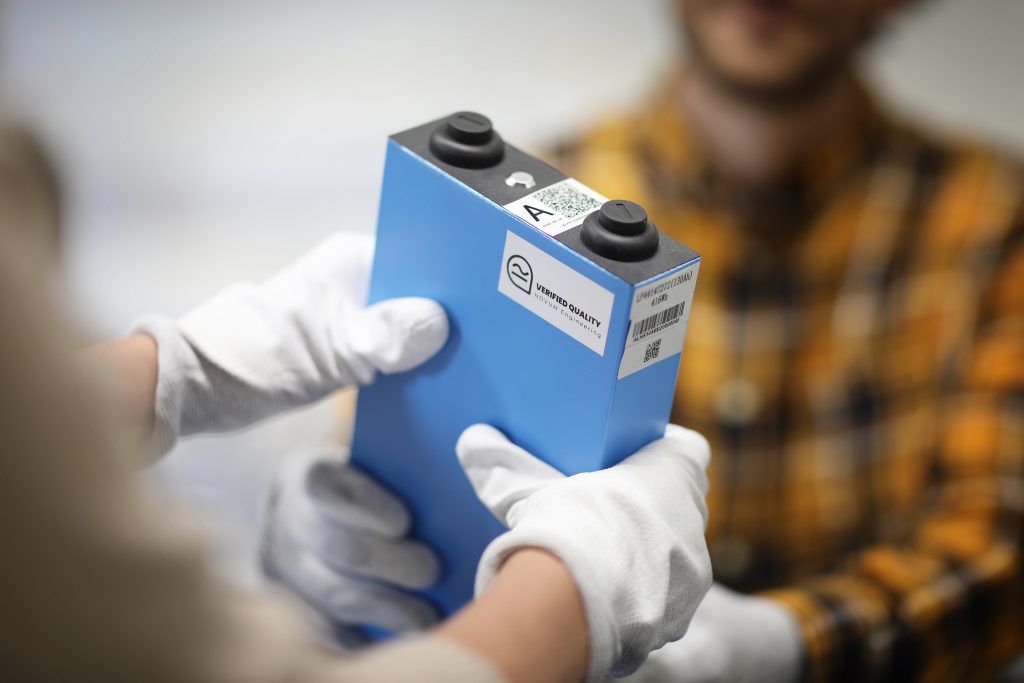The aging tendency of a battery describes the extent to which a battery reacts to environmental influences. The greater the aging tendency, the more strongly a battery reacts to environmental influences and the more likely it is that the battery will fail, heat up or even burn and explode. The aging tendency of battery cells is already determined during production.
The following influencing factors are decisive for the aging tendency of batteries:
- Purity of the materials in the individual cells
- Humidity and purity of the air during production
- Homogeneity of the battery cells
- Formation of the battery cells
The formation of battery cells in particular plays a decisive role. In this process, the cells are “run in” under controlled conditions and thus made fit for later use. If the formation is omitted or carried out poorly, storage tanks consisting of such cells age much faster in later use and sometimes become real safety risks.
For companies, it is essential to avoid scenarios in which overheating can occur, for example. A battery fire of over 1000 degrees cannot be extinguished by conventional means. People can be injured, employees permanently incapacitated by the toxic fumes. The financial damage is often enormous for affected companies. Even more serious, however, is the damage to reputation and the loss of trust among partners and customers.
To ensure that batteries in vehicles, devices or battery storage systems do not pose a risk and perform their function as expected, it is therefore advisable to determine the aging tendency directly after production and also keep an eye on it later. With NOVUM technology, this works easily, quickly and cost-effectively.

Battery aging
In contrast to the aging tendency, which is fixed with the production of the battery, the aging of the battery describes the process in which the performance of a battery — as with all electrochemical systems — decreases. How quickly a battery ages can be influenced by various factors that users in particular, both companies and end users, are often not even aware of.
Calendar aging
Especially important: A battery always ages — even when it is not in use. This is referred to as calendar aging . Over time, the materials inside the battery simply fatigue until at some point it is no longer serviceable.
This effect is accelerated by temperatures that are too high or too low and a state of charge that is too high or too low (State of Charge SoH). If an unfavorable state of charge meets unfavorable temperature conditions, safety-relevant problems develop very quickly. Therefore, batteries should at best always be stored at room temperature and a state of charge of 30%. However, this alone is still not a guarantee of safety.
Cyclic aging
The second form of battery aging is very well known to most users: cyclic aging. This includes all aging phenomena caused by the use of batteries, i.e. charging and discharging.
The greater the load on a battery, the greater the cyclic aging. The decisive factors here are, above all, current strength and voltage. How much current and how much voltage a battery can handle changes over the course of its useful life. For example, most batteries tolerate higher values at the beginning of their life cycle than towards the end.
This makes it all the more important to permanently monitor the load on batteries using modern methods so that they are only exposed to as much current and voltage as they can handle. If they are operated beyond their load limits, they not only age more quickly, but also become a safety risk.
Erratic aging
The third form of battery aging is represented by erratic aging phenomena. These are particularly difficult to predict because they are usually triggered by sudden events such as pressure or short circuits.
A short circuit is usually preceded by a longer process inside the battery. In a process known as dentrite formation, disruptive structures grow inside the battery and eventually puncture the separator (a kind of partition between the — and + sides of the battery), causing the battery to short circuit and burn out or explode.
Dentrite formation is very difficult to see by conventional means, but can be detected early with the impedance spectroscopy measurement method used by NOVUM. This means that even if a battery is not that old and does not show any other abnormalities, we can already indicate that processes are taking place in the battery chemistry that make this battery a safety risk for its users.

In summary, battery aging is composed of the following 4 elements:
- aging tendency, which the battery (cell) brings along by its production
- calendrical aging, which depends on the environmental influences to which a battery is exposed
- cyclic aging, which is determined by how much the battery is used
- erratic aging, which includes all unforeseen e.g. physical influences
The more unfavorable aging factors interact, the more unfavorable for battery safety and the more important it is to have batteries permanently under control.




